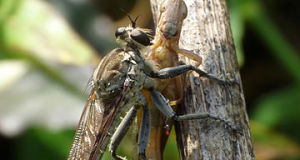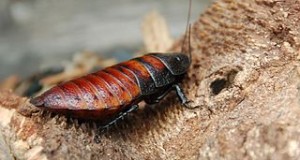Mantids (a/k/a praying mantis) are growing in popularity among invertebrate keepers, with a number of species now being regularly bred in captivity. Ranging in size from minute stick-mimics to 10-inch-long behemoths capable of capturing mice and lizards, the world’s 2,400+ mantid species are among the insect world’s most fascinating members, and many are well suited to terrarium life.
Sociable Mantids?
 Praying mantids vie with weasels and shrews as the most rapacious of all predators…I once saw a female Chinese mantid (Tenodera aridifolia sinensis) catch and consume a hornet while she was copulating! Females of many species eat their mates, often during the act of mating.
Praying mantids vie with weasels and shrews as the most rapacious of all predators…I once saw a female Chinese mantid (Tenodera aridifolia sinensis) catch and consume a hornet while she was copulating! Females of many species eat their mates, often during the act of mating.
However, some species, including the popularly-kept dead leaf mantid (Tenodera aridifolia), get along quite well together. I have raised clutches of dead leaf mantids with very few losses….perhaps several hanging upside down from a branch, as is their habit, are better camouflaged than would be a single individual.
Camouflage Artists
All mantids studied thus far are supremely well-camouflaged, mimicking, among other things, leaves, sticks, bark and lichen. Orchid mantids so closely resemble their namesakes that insects often alight directly upon them, mistaking the spectacularly-colored predators for flowers.
Farmer’s Friend
Insatiable appetites have long endeared mantids to farmers the world over. The Chinese mantid was imported into the USA in 1896 to battle agricultural pests. Exceeding the nation’s 20 native species in size, the Chinese mantid may consume upwards of 2,000 insects during its lifetime. Millions of its egg cases, or oothecum, are still sold annually for use in gardens, greenhouses and farms.
The European or praying mantid (Mantis religiosa) appeared in the USA in 1899, as a stowaway. Armed with a taste for the tree-killing gypsy moth (also a European introduction), the new insect predator quickly found favor in its adopted home. Today both mantids are widely distributed throughout the USA.
My own introduction to mantid rearing, at age 7, involved a famous entomologist and chop meat waved about on toothpicks. I’ll cover that story and mantid care in the future.
Further Reading
To learn more about mantid natural history and biology, please visit
http://www.discoverlife.org/mp/20o?search=Mantodea.
Image referenced from Wikipedia and originally posted by GRBerry.
 That Reptile Blog – Reptile, Amphibian and Exotic Pet Care and Information
That Reptile Blog – Reptile, Amphibian and Exotic Pet Care and Information


